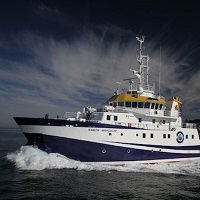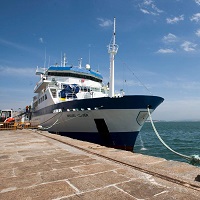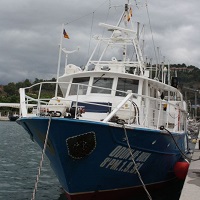Keyword
water body temperature sensor
59 record(s)
Type of resources
Categories
Topics
INSPIRE themes
Keywords
Contact for the resource
Provided by
Years
Formats
Status
-

The main aim of the Triennial surveys is to estimate the spawning stock biomass of mackerel and horse mackerel applying the Annual and Daily Egg Production Method (AEPM and DEPM). The method relates the number of freshly spawned eggs found in the water column to the number of female having produced these eggs. Knowing the fecundity of the females and the sex ratio provides an estimate for the spawning-stock Biomass. In the frame of the ICES WGMEGS,AZTI is in charge of sampling the area of the Bay of Biscay. Sampling consist in collecting plankton samples to identify and stage the mackerel and horse mackerel eggs. Environmental parameters: At each station profile of sea temperature and salinity are recorded.
-

The main aim of the Triennial surveys is to estimate the spawning stock biomass of mackerel and horse mackerel applying the Annual and Daily Egg Production Method (AEPM and DEPM). The method relates the number of freshly spawned eggs found in the water column to the number of female having produced these eggs. Knowing the fecundity of the females and the sex ratio provides an estimate for the spawning-stock Biomass. In the frame of the ICES WGMEGS,AZTI is in charge of sampling the area of the Bay of Biscay. Sampling consist in collecting plankton samples to identify and stage the mackerel and horse mackerel eggs. Environmental parameters: At each station profile of sea temperature and salinity are recorded.
-

The main aim of the Triennial surveys is to estimate the spawning stock biomass of mackerel and horse mackerel applying the Annual and Daily Egg Production Method (AEPM and DEPM). The method relates the number of freshly spawned eggs found in the water column to the number of female having produced these eggs. Knowing the fecundity of the females and the sex ratio provides an estimate for the spawning-stock Biomass. In the frame of the ICES WGMEGS,AZTI is in charge of sampling the area of the Bay of Biscay. Sampling consist in collecting plankton samples to identify and stage the mackerel and horse mackerel eggs. Environmental parameters: At each station profile of sea temperature and salinity are recorded.
-

The main aim of the Triennial surveys is to estimate the spawning stock biomass of mackerel and horse mackerel applying the Annual and Daily Egg Production Method (AEPM and DEPM). The method relates the number of freshly spawned eggs found in the water column to the number of female having produced these eggs. Knowing the fecundity of the females and the sex ratio provides an estimate for the spawning-stock Biomass. In the frame of the ICES WGMEGS,AZTI is in charge of sampling the area of the Bay of Biscay. Sampling consist in collecting plankton samples to identify and stage the mackerel and horse mackerel eggs. Environmental parameters: At each station profile of sea temperature and salinity are recorded.
-

Training of students of the Master of Marine Sciences: Oceanography and Marine Environment Management of the University of Barcelona.
-

The main aim of the Triennial surveys is to estimate the spawning stock biomass of mackerel and horse mackerel applying the Annual and Daily Egg Production Method (AEPM and DEPM). The method relates the number of freshly spawned eggs found in the water column to the number of female having produced these eggs. Knowing the fecundity of the females and the sex ratio provides an estimate for the spawning-stock Biomass. In the frame of the ICES WGMEGS,AZTI is in charge of sampling the area of the Bay of Biscay. Sampling consist in collecting plankton samples to identify and stage the mackerel and horse mackerel eggs. Environmental parameters: At each station profile of sea temperature and salinity are recorded.
-

Multidisciplinary campaing for mooring instruments and adquiring samples and variables to: * Know the thermohaline, kinematic, dynamic and biological characteristics of the Gulf of Cadiz. * Study of carbon fluxes between the Atlantic and Mediterranean. * Linking climatology, hydrology and hydrodynamics and the early stages of development of the species associated with the platform, with a focus on species of fishing interest. * Provide data to feed global and regional numerical models. * Generate and distribute a database to know the evolution of marine climate and its resources.
-

The main objectives are understanding the inter-annual variability of Bluefin Tuna spawning sites and the application of operational oceanography to the conservation and management of tuna species in the Balearic Sea. The main activities have focused on the development of predictive models of Bluefin Tuna spawning locations.
-

The main objectives are understanding the inter-annual variability of Bluefin Tuna spawning sites and the application of operational oceanography to the conservation and management of tuna species in the Balearic Sea. The main activities have focused on the development of predictive models of Bluefin Tuna spawning locations.
-

1. Calibration and testing transducers noise. 2. To estimate the abundance of the main pelagic fish (sardines, anchovies, mackerel, etc.) by the method of echo integration in the northern Spanish coast and map their range. 3. Determine the main biological characteristics of target fish species: age structure and length, length / weight ratio and maturity stage from sampling biological sardine, anchovy, mackerel, horse mackerel, horse mackerel, chub mackerel, blue whiting and hake. 4. Determine the size structure of all fish species caught. 5. Estimate the TS / length ratio of the target species 6. To estimate the relative abundance and mapped the distribution of sardine and anchovy eggs. 7. Characterization of the hydrological conditions of the survey area, especially thermohaline properties of the waters over the continental shelf. Measurement of vertical profiles of temperature, salinity and fluorescence in stations (CTD Casts) and acquisition of continuous sea surface data (ttemperature, salinity and fluorescence). 8. Study of the relationship of oceanographic and meteorological conditions with distribution and abundance of sardine eggs and adults. 9. Determine the distribution patterns of taxonomic diversity and biomass different size classes of plankton (pico-, phyto- and zooplankton) in the study area. 10. Characterize the horizontal and vertical distribution of plankton. Mapping biomass plankton size classes 11. Plankton biomass estimation, fractional and total. Studying the relationship between ichthyoplankton and plankton. 12. Estimate the natural abundance of N15 in sardine, anchovy, mackerel, and krill and myctophids to determine their trophic position. 13. Mapping the abundance of top predators 14. Map the relative abundance of anthropogenic sea surface microplastic 15. Estimate the strength of recruitment of anchovy and other species in the Cantabrian observed during the JUVENA campaign. 16. Estimate blue whiting biomass in Porcupine Seabight in coordination with the other nations performing the International Blue Whiting Spring Survey (IBWSS).
 Catálogo de datos del IEO
Catálogo de datos del IEO